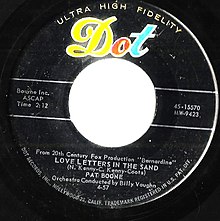Love letters in the sand
Love Letters in the Sand is a pop song by Nick and Charles Kenny (lyrics) and J. Fred Coots (music) from 1931. The song was best known in the version released by Pat Boone in 1957, which became a million seller and developed into the singer's most successful hit.
History of origin
The song was written in 1931 by the brothers Nick and Charles Kenny (lyrics) and J. Fred Coots (music) and was melodically based on the title The Spanish Cavalier about a brave, which was registered for copyright by composer William D. Hendrickson on March 12, 1881 American soldiers. The Spanish Cavalier appeared in 1915 in the Cable Company's The One Hundred and One Best Songs music book. The piece was first recorded by Riley Puckett in the style of old-time music on September 12, 1924, then by The Sons of the Pioneers on March 14, 1944.
Nick and Charles Kenny first wrote a poem that appeared in a newspaper. When composer Fred Coots read this poem, he varied the original melody of The Spanish Cavalier and combined it with the text of the poem. A new song was created under the title Love Letters in the Sand , which was registered for copyright on July 10, 1931. The text compares an ending love affair with ephemeral and fleeting expressions of love written in the sand. Gene Austin's version, recorded shortly after the copyright was filed on August 9, 1931 ( Brunswick Records 6188), is therefore considered the original, followed by Lloyd Keating on August 20, 1931 (Clarion 11002); Ted Black's Orchestra with Tom Brown (vocals) in Tin Pan Alley style on August 27, 1931 was the only version to reach the US pop hit parade with number 6 ( Victor 22799). Within a short time, other versions of Lee Morse & Her Bluegrass Boys (September 4, 1931), Ruth Etting (September 9, 1931), Victor Young & Brunswick Orchestra (September 16, 1931) and the Radiolites (alias Ben Selvin ) from September 18 , 1931, appeared September 1931 were further versions. The Majestic Dance Orchestra followed on September 1, 1931, then Sam Lanin 's Orchestra (released October 15, 1931).
After the briefly consecutive cover versions in the year of publication, the title was not picked up again until November 1953 by Mac Wiseman .
Cover version by Pat Boone
The ballad- shaped Pat Boone version of Love Letters in the Sand was the most successful of all versions. As early as November 24, 1956, Boone was in the recording studios of Radio Recorders in Los Angeles to record the song. Boone is accompanied by Barney Kessel and Jack Marshall (guitars), Larry Breen (bass), Milt Adelstein (piano), Dave Peel (saxophone) and Dick Shanahan (drums) as well as a background choir. In the instrumental part of the song, Boone whistles the melody. The arranger and conductor was Billy Vaughn , producer Randy Wood. It's four-four time , but the accompaniment, especially the piano, plays triplets. The chord is repeated three times on each beat. Further recordings followed on February 5 (fast version) and March 24, 1957, but they did not come on the market.
After publication on April 10, 1957, the single Love Letters in the Sand / Bernardine ( Dot Records 15570) reached first place on the US pop hit parade on June 3, 1957, where it stayed a total of 5 weeks; it reached number 2 in the UK. The single sold 3.5 million copies. The sales success was reinforced by the movie Bernardine , which premiered on July 25, 1957. In it Pat Boone plays the lead role and sings his hit. Boone received a platinum record for his biggest hit . This sixth million seller of the successful singer was followed by other high-turnover singles; however, they did not achieve the success of this world hit.
More cover versions
The German-language original was published in 1957 by Kenneth Spencer - an American bass-baritone opera singer - with the Hansen Quartet under the title Come to me, if you're lonely (German text: Ralph Maria Siegel , Columbia 20369), it was followed by Vico Torriani & The Sunnies (June 1959). Then Bill Haley tried to revitalize his career with the original text (April 1960), followed by Patsy Cline (published April 27, 1964). Pat Boone brought the German-language single Baby, Oh Baby / Come to me, when you are lonely with the music track of his world hit on the market in July 1963. Bernd Opinion wrote a new German text for Tommy Steiner under the title The letter he wrote in the sand (LP Tommy Steiner ; July 1983), the Flippers adapted the melody for Midsummer Night's Dreams (LP Liebe ist… ; March 1989). A total of at least 57 versions have appeared.
Individual evidence
- ^ Catalog of Copyright Entries - Musical Compositions , Part 3, 1932, p. 906
- ^ Don Tyler, Music of the Postwar Era , 2008, p. 97
- ^ Joseph Murrells, Million Selling Records , 1985, p. 105

